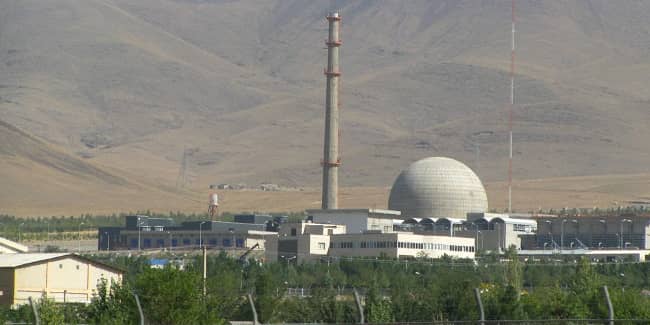Is Ali Khamenei, the Iranian regime’s supreme leader, five months away from building a nuclear bomb? Analysis of the IAEA Monitoring and Verification Report of February 2021 indicates that Iran’s regime is only five months away from two atomic bombs.
The website of the Institute for Science and International Security wrote on February 25, 2021, in a report by David Albright, Sarah Burkhard, and Andrea Stricker: “Iran’s nuclear escape time in February 2021 has been reduced to 3.1 months. The Iranian government now has less than 5 percent enriched uranium at the weapons level for the second nuclear weapon, which produces a second bomb faster than the first. “In total, it takes only five months to produce enough uranium (WGU) for two bombs.”
The Institute for Science and International Security wrote: This report assesses the information in the quarterly report of The Protocol of Accession of the International Atomic Energy Agency (IAEA) on February 23, 2021, and the verification and monitoring in the Islamic Republic of Iran in connection with UN Security Council Resolution 2231, including Iran’s compliance with the IAEA Board.
The IAEA released the report on the day the Iranian regime announced it would suspend implementation of the Additional Protocol to the Comprehensive Safeguards Agreement (CSA), a step forward in nuclear development.
Rafael Grossi, the IAEA Director General, traveled to Tehran last weekend, and the Iranian regime agreed to continue implementing the Additional Protocol for a limited number of verification and monitoring activities for three months and to comply with its safeguards, including the IAEA inspection and IAEA access arrangements at any site in Iran.
Summary of nuclear breakout time estimates
1. The Iranian government has started enriching uranium to 20% since January 4, 2021.
2. The Iranian government has produced 3.6 grams of uranium metal from natural uranium fluoride at the fuel plate manufacturing complex in Isfahan and tested the uranium metal production process.
3. Iranian-style enriched uranium has often gone too far. On February 16, 2021, it reached 4390.2 kg, almost all of which was enriched below 5%.
4. Iran has 17.6 kg of 20% enriched uranium.
The breakout time of the Iranian government was reduced to 5 months
5. Monthly production of light uranium increased by 5% from 146.7 kg per month in February 2021 to 205.5 kg per month.
6. Iran’s nuclear breakout time in February 2021 has been reduced to 3.1 months. Iran now has less than 5 percent enriched uranium at the level of uranium production at the weapons level for the second nuclear weapon, the second bomb being produced faster than the first bomb.
7. Iran’s total estimated capacity in Natanz and Fordow from 6963 separate work units (SWU) per year to 8258 SWU has reached the year in current centrifuges. That is, it has increased by 20%.
Uranium’s enrich has tripled compared to JCPOA
8. The current enrichment capacity in Natanz Fuel Enrichment Complex and in Fordow Complex without considering Natanz Pilot Fuel Enrichment Complex to 6744 SWU And has arrived in the year. If Iran has a set of advanced centrifuges that it is currently installing, its total capacity will be about 12,900 SWU arrives annually, which is three times the legal limit.
9. The amount of heavy water in Iran until February 15, 2021, was 131.4 metric tons. Which is higher than the limit of JCPOA, i.e., 130 metric tons. Iran has also transported 5.4 metric tons of heavy water abroad.
10. Iran has not pursued the reconstruction of the Arak Reactor.
Background
The Iranian regime’s nuclear weapons program remained secret until 2002 when the National Council of Resistance of Iran held a press conference revealing a uranium enrichment facility at Natanz and a Heavy Water plant at Arak.
Those revelations, based on information provided by the social network of the People’s Mojahedin Organization of Iran (PMOI), triggered an investigation by the International Atomic Energy Agency (IAEA) that eventually brought the regime’s nuclear file before the UN Security Council for punitive sanctions.
The earliest NCRI revelations of the regime’s nuclear projects date back to 1991, but these fell on deaf ears in the West. Since 2002, the NCRI has held dozens of press conferences in Western capitals revealing various top secret nuclear sites and information about key personnel involved in the regime’s nuclear projects.
In 2003, the NCRI exposed an enrichment project going on at the Lashgar-Abad site near Karaj. After a 2004 inspection by the IAEA, it was discovered that work was being done at the site on a laser enrichment project.
In 2004, the NCRI disclosed the existence of a nuclear facility at Lavizan (Lavizan II) and enrichment-related activity at the Parchin site. In 2008, the NCRI exposed a command and development center for nuclear weapons at the Mojdeh site, along with its various components, which included laser enrichment. In 2010, the NCRI exposed details of a nuclear enrichment site at Abyek.
In 2012, the NCRI exposed secret details of the role of the Revolutionary Guards in the regime’s nuclear weapons projects.
The NCRI’s own political platform rejects nuclear weapons or technology being pursued in Iran, and Mrs. Rajavi’s 10-point plan for a future Iran specifically states: “We want the free Iran of tomorrow to be devoid of nuclear weapons and weapons of mass destruction.”
Read more: A Look at Iran’s Nuclear Weapons Projects
